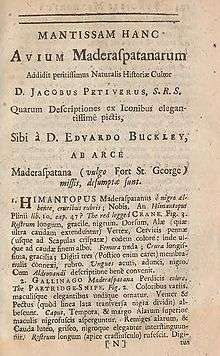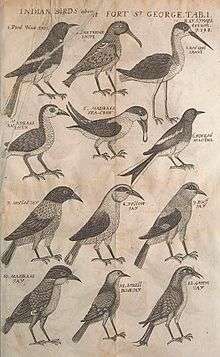Edward Bulkley

Edward Bulkley (?-10 August 1714) was an East India Company surgeon (1602-1709) posted in Madras and a pioneer naturalist. He corresponded with Petiver and was the first to document the bird species of which a list of birds was published by John Ray. Ray incorrectly notes him as "Buckley". Bulkley also studied the local plants and corresponded with the Jesuit botanist Georg Joseph Kamel and acted as an intermediary between Kamel and Petiver. Bulkley corresponded with Charles du Bois on plants and collected Tamil and Telugu names for many medicinal and economically useful plants. Surgeon Bulkley is credited with conducting the first post-mortem in India.[1] The case involved the death of James Wheeler in 1693 and the only previous such examination was in November 1680 when a soldier, Joshua Adams was killed by a strike on the head by Daniel Hughes. An examination of just the scalp was made but in Bulkley's case he conducted a complete autopsy. James Wheeler was a member of the Council of Madras and had been treated by Samuel Browne and the maker of the medicine (ground pearl) had used a pestle-and-mortar that was thought to have been used earlier for arsenic. Wheeler died from suspected arsenic poisoning but Browne was acquitted.[2][3][4]
Bulkley was a correspondent of several naturalists in England and maintained correspondence with Petiver after the death of Browne.[5] Bulkley sent samples of soils from India to J. Woodward who included them in his 1729 catalogue.[6]

Edward Bulkley also served as a Member of the Council of Madras and as a Paymaster. He resigned from work due to ill health in February 1713. He was buried in his garden in Peddanaikpetta, now in the Army lines opposite the Madras Medical College. The inscription on his tomb reads Sacrum sit hoc monumentum perenni memoriae Edwardi Bulkley, Honorabili Anglorum Societati medici, feliciter experti et ipsae tandema consiliis, qui cum naturae arcana diu indagasset, laeto animo ipsae satisfecit viii. Augusti MDCCXIV, et anno aetatis suae climacterico. Ne mireris viator quod in horto ubi animum perpoliebat, corpus suum voluit reponi, beatam sperans ressurectionem. His funeral sermon was given by Rev. William Stevenson at St Mary's.[8]
References
- ↑ Mathiharan, Karunakaran (2005). "Origin and Development of Forensic Medicine in India". American Journal of Forensic Medicine & Pathology. 26 (3): 254–260.
- ↑ Crawford, D.G. (1914). A history of the Indian Medical Service 1600-1913. Volume I. London: W. Thacker & Co. p. 70.
- ↑ Winterbottom, Anna (2016). Hybrid knowledge in the early East India Company world. Palgrave Macmillan. pp. 112–133.
- ↑ Wheeler, J. Talboys (1861). Madras in the olden time being a history of the Presidency. Madras: J. Higginbotham. pp. 277–278.
- ↑ Raven, Charles E. (1986). John Ray: Naturalist: His Life and Works. Cambridge University Press. p. 302.
- ↑ An attempt towards a natural history of the fossils of England. Volume 2: An addition to the catalogue of the foreign native fossils in the collection of J. Woodward. London. 1729. pp. 2–3.
- ↑ Ali, Salim (1979). Bird study in India: its history and its importance. Indian Council for Cultural Relations.
- ↑ Love, H.D. (1913). Vestiges of Old Madras. Volume II. p. 146.